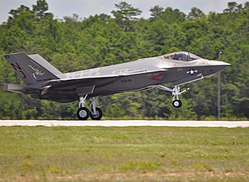VFA-101
| Strike Fighter Squadron 101 | |
|---|---|
F-35C Lightning II |
Strike Fighter Squadron 101 (VFA-101), also known as the "Grim Reapers", was a
History
Two distinct squadrons have been called the Grim Reapers, VF-10 and later VF-101, which is the main subject of this article. Officially, the US Navy does not recognize a direct lineage with disestablished squadrons if a new squadron is formed with the same designation or nickname.[3] Often, the new squadron will assume the nickname, insignia, and traditions of the earlier squadrons.
1950s

On 1 May 1952, VF-101 was established at
In 1956, VF-101 transitioned to the
1960s
In June 1960, VF-101 established "Detachment A" at NAS Oceana which operated the
1970s

VF-101’s administrative command, Readiness Attack Carrier Air Wing 4, was disestablished on 1 June 1970, with VF-101 shifting control of Command to Fleet Air Key West. This moved lasted only a year, and the squadron moved from NAS Key West to NAS Oceana under the command of Commander Fighter Wing One. A detachment remained at Key West until the 2000s. From 6 July to 16 December 1971, VF-101 Det.66 was assigned to
In January 1976, VF-101 began operating and instructing aircrews and maintainers in the F-14 Tomcat. In 1975 and 1976 the squadron was awarded the
1980s
In 1986, VF-101 had completed 3 years of accident free operations earning them another Safety Citation, and in March 1988 they received a third CNO Safety Award. The same year, VF-101 began to receive the F-14A+ (later redesignated F-14B), which upgraded the F-14A's underpowered and troublesome engines with new engines that improved fuel economy and added 14,600 pounds-force (65,000 newtons) of thrust over the F-14A. The new fuel economy gave the F-14B one third more time on-station and sixty percent more range.
1990s

Following a year of dedicated fleet efforts, led primarily by
VF-101's West Coast counterpart, VF-124 at
2000s
As F-14 squadrons began to transition to the
VF-101 was deactivated on 30 September 2005, at a ceremony at NAS Oceana. Honored guests at the ceremony were the surviving members of the Flatley family (three generations of which were VF-101 pilots), who were presented with the squadron flag.
Reactivation and redesignation to "VFA-101" as F-35C Fleet Replacement Squadron

On 1 May 2012, the squadron was reactivated at
Deactivation
On 10 September 2018, the Chief of Naval Operations promulgated a notice of the "Deactivation of Strike Fighter Squadron One Zero One." .[7] On 23 May 2019, VFA-101 completed deactivation, and was consolidated into the remaining F-35C FRS, VFA-125, the "Rough Raiders". Its assets and support personnel were moved to NAS Lemoore, home of VFA-125.[1]
See also
- Naval aviation
- Carrier-based aircraft
- List of United States Navy aircraft squadrons
- List of Inactive United States Navy aircraft squadrons
Notes
- ^ a b "Strike Fighter Squadron 101 Deactivates". Archived from the original on 26 February 2020. Retrieved 23 May 2019.
- ^ a b "Navy's Newest Squadron Prepares for New F-35 Fighters". www.navy.mil. Archived from the original on 13 June 2013.
- ^ "Naval Aviation Squadron Lineages". www.history.navy.mil. Archived from the original on 26 May 2000.
- ISSN 0028-1417)
- ^ "Air Force Times". Airforcetimes.com. Retrieved 20 November 2021.
- ^ "Navy's First F-35C Lightning II Squadron Surpasses 1000 Flight Hours". www.navy.mil. Archived from the original on 29 November 2014.
- ^ "Home - Secretary Of The Navy" (PDF). Secnav.navy.mil. 9 August 2021. Retrieved 20 November 2021.

